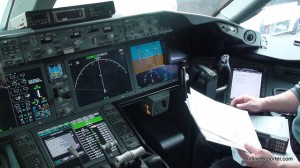
Cockpit of a Boeing 787 Dreamliner. Uh oh, is that electronic device authorized?
“Sit down, shut up and turn off your electronic devices!” Okay, it is not really that bad, but sometimes I get pretty annoyed when I have to turn off my personal electronic device (PED) during taxi. I am a spoiled American and if we are delayed on the tarmac for take off, not having access to my precious electronic devices is difficult. So why the heck are you required to turn your devices off anyhow? And can they really bring down a plane?
If something happens to the plane and you are on above 10,000 feet, you have time. Time to try to navigate to an airport, time to put your toys away before landing. When you are below 10,000 feet things need to happen quickly and it is more dangerous.
One of the important reasons you have your devices off, is to make sure you are paying attention. First you need to pay attention to the flight attendants giving their safety announcement (they don’t do it for fun). Secondly, you should be paying attention to your surroundings. If the plane catches on fire while taxiing out, you need to be ready to react, not listening to the newest Justin Bieber song (is he still “cool” — I dunno). You also need to be able to get out of the plane as soon as possible. If there are cords and cables in the way and your neighbor is distracted, that can slow things down, causing people injury or possibly death.
Next are those pesky electronic signals. All electronic devices give off some sort of signal that could interfere with the cockpit. Even the Federal Aviation Administration isn’t too sure how much these signals affect the avionics in an airliner, but are playing it safe. The FAA’s website states site, ’œthere are still unknowns about the radio signals that portable electronic devices and cell phones give off.’
Airplane manufacturers, airlines and the FAA work together to make sure that any electronic equipment that might go into an airplane will not cause it harm. According to Flight Global, recently on board Wi-Fi tests resulted in some Honeywell avionics to react adversely. This goes to show that yes, electronic equipment can affect instruments, but it also shows that rigorous testing by all those involved make sure that these sort of things won’t happen past the testing phase. Currently all those involved are working together to find the cause and a solution.
Yes, it might be annoying to put your devices away, but I think there are some very valid reasons for doing so. Next time you are on a flight and you hear the call to turn off your devices, be a good sport and do as you are told.
For more information and quotes from Boeing, Virgin America and the FAA, check out my story on AOL Travel News.
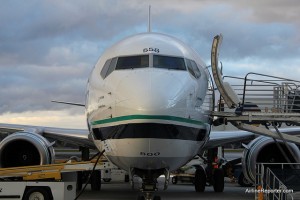
Alaska Airlines Boeing 737-800 ready to go.
Sometimes when things go wrong, it is an opportunity to show what you are made of. On Saturday, Alaska Airlines computer system, used to plan flights, went offline due to a blown transformer. It took over 24 hours to get the system fully running again and there are still passengers who are trying to get to their destination.
From the media’s perspective, Alaska was on their game. During the outtage they posted four different press releases, allowing the media to update passengers. When this sort of thing happens with most other airlines, the media is lucky to get one press release after everything is said and done.
For passengers, both Alaska and Horizon effectively used their social media outlets to not only keep customers informed, but to apologize for the inconvenience. Alaska alone had about 25 tweets about the outage, either providing updates or talking directly to customers who needed assistance. Alaska Air President Brad Tilden and Horizon Air President Glenn Johnson also made a video apologizing for the delay, something that I have never seen an airline do, especially in the middle of the situation.
Now realize, this is all going on over the weekend. All these airline folks were working diligently to get the system back up and keep their customers informed. For me, that is true dedication.
Most airlines are too afraid to have such a public voice when something goes wrong. It takes a risk to be so public when things go wrong, but I think it seperates the good airlines from the great. Even though the computer crash only affected 18% of their flights, it is still a huge impact. Alaska did have to cancel 150 flights, affecting 12,000 passengers. Sure, for many passengers this outreach didn’t mean much help them feel better about not seeing grandma, but just like every other industry out there, airlines are prone to things going wrong. The airline business is extremely complicated and this just goes to show how something relatively minor can have such a large impact.
Cheers to Alaska Airlines and Horizon Air for being so open with the issues and getting them solved.
Alaska gets more kudos from Dan Webb via his blog Things in the Sky Blog and Brett Snyder on CrankyFlier.com.
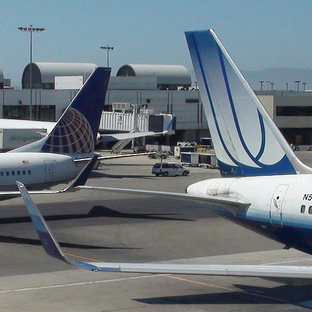
Two will enter, one will leave. Some will have Wi-Fi.
United has announced today that Continental intends to add Wi-Fi to 200 of their Boeing 737 and 757 aircraft. It is not officially, official that this will happen, but I would imagine it will go through.
If you get confused on who and what United and Continental Airlines are right now, you are not alone. Although they will be merging, they are still two separate airlines. This gets more confusing since they have started to re-paint planes and doing joint announcements.
Add to the confusion that currently, United flies fourteen aircraft with Wi-Fi already on their Premium Service (PS). 13 of those aircraft are using Go-Go Inflight Wi-Fi and one is using Row 44. The Continental aircraft will be using LiveTV’s ViaSat-1 satellite internet. Those are a lot of different providers and I would imagine as the merger settles down, the new United will be looking at which service package they would want to provide to the entire fleet. Since the new United has so many international destinations, it makes sense for them to look at using a satellite provider like Row44 or LiveTV.
Becoming the world’s largest airline is not easy. There are a lot of things that still need to be dealt with to make sure the new United has a consistent brand.Time is of the essence since the new United doesn’t want to alienate loyal customers for both airlines during the transition.
To learn a bit more, check out my story on AOL Travel News.
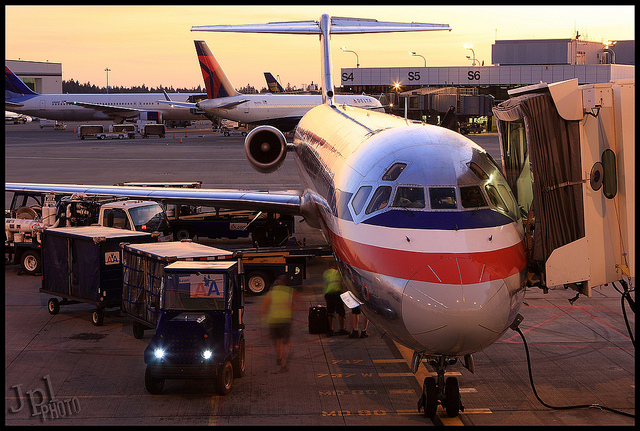
An American Airlines MD-80.
I love the self-service kiosks at airports. I was one of the first people to use them when they came out and I am still a huge fan today.
One of the most annoying issues is printing out my boarding pass and then waiting for someone to come over and give me my bag-tag. Sometimes I can end up waiting longer for my tag than I took actually checking in. American Airlines is trying to change the game by allowing passengers to print off their own bag tags.
Already at 35 airports around the world, passengers can print off their own luggage tag, but that hasn’t been the case in the US. American is giving this a six month test in Austin, TX to see how it goes. Your ID still needs to be checked, and an agent needs to watch the conveyor belt to make sure only authorized bags make their way on board, but this should be able to speed up the check-in process.
Some passengers and airline employees are not happy. Passengers feel this is a step backward with customer service and employees are afraid about keeping their job. I think it boils down to the cost of a ticket. Airlines need to get creative to be competitive and if this is a way to speed things up and save a few dollars on a ticket, I wouldn’t be surprised to see it being used more in the future. Delta and Alaska Airlines have already shown some interest and I imagine that others are keeping a close eye on how this goes.
What do you think? Is this the future or a lame-duck idea?
To learn more about this program, check out the story I posted on AOL Travel News.
Image: John Rogers
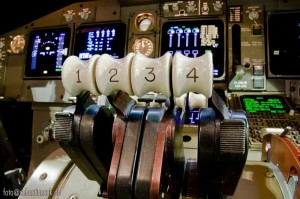
Throttles of a Boeing 747-400.
Flashing lights, warning alarms and that shrieking voice saying “pull up.” There are a lot of emergency indicators in the cockpit of an airliner and Boeing is looking at adding another. The warnings already hit two senses: sight and hearing… it’s time to add touch. Boeing submitted a patent application to make the pilot’s seat vibrate in a number of different situations, but not only in emergencies. Can this help keep pilot’s awake during flight? It sure can’t hurt.
Learn more about how the seats will work, why Boeing is looking at this option over at my story on AOL Travel News.
Image: Sebastian Suk




